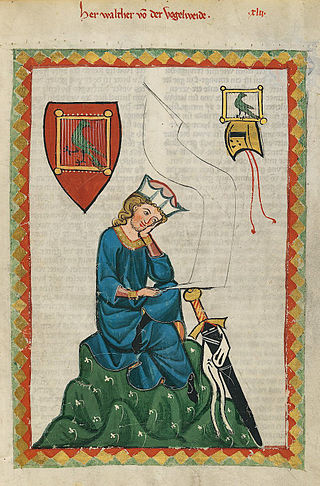
Franconia is a region of Germany, characterised by its culture and East Franconian dialect . Franconia is made up of the three Regierungsbezirke of Lower, Middle and Upper Franconia in Bavaria, the adjacent, Franconian-speaking South Thuringia, south of the Thuringian Forest—which constitutes the language boundary between Franconian and Thuringian—and the eastern parts of Heilbronn-Franconia in Baden-Württemberg.

German literature comprises those literary texts written in the German language. This includes literature written in Germany, Austria, the German parts of Switzerland and Belgium, Liechtenstein, Luxembourg, South Tyrol in Italy and to a lesser extent works of the German diaspora. German literature of the modern period is mostly in Standard German, but there are some currents of literature influenced to a greater or lesser degree by dialects.

Jacob Ludwig Karl Grimm, also known as Ludwig Karl, was a German author, linguist, philologist, jurist, and folklorist. He formulated Grimm's law of linguistics, and was the co-author of the Deutsches Wörterbuch, the author of Deutsche Mythologie, and the editor of Grimms' Fairy Tales. He was the older brother of Wilhelm Grimm; together, they were the literary duo known as the Brothers Grimm.

The bourgeoisie are a class of business owners and merchants which emerged in the Late Middle Ages, originally as a "middle class" between peasantry and aristocracy. They are traditionally contrasted with the proletariat by their wealth, political power, and education, as well as their access to and control of cultural, social, and financial capital.

The Dark Ages is a term for the Early Middle Ages, or occasionally the entire Middle Ages, in Western Europe after the fall of the Western Roman Empire, which characterises it as marked by economic, intellectual, and cultural decline.

Ferdinand Gregorovius was a German historian who specialized in the medieval history of Rome.

A fief was a central element in medieval contracts based on feudal law. It consisted of a form of property holding or other rights granted by an overlord to a vassal, who held it in fealty or "in fee" in return for a form of feudal allegiance, services or payments. The fees were often lands, land revenue or revenue-producing real property like a watermill, held in feudal land tenure: these are typically known as fiefs or fiefdoms. However, not only land but anything of value could be held in fee, including governmental office, rights of exploitation such as hunting, fishing or felling trees, monopolies in trade, money rents and tax farms. There never existed a standard feudal system, nor did there exist only one type of fief. Over the ages, depending on the region, there was a broad variety of customs using the same basic legal principles in many variations.

Minnesang was a tradition of lyric- and song-writing in Germany and Austria that flourished in the Middle High German period. This period of medieval German literature began in the 12th century and continued into the 14th. People who wrote and performed Minnesang were known as Minnesänger, and a single song was called a Minnelied.

A codpiece is a triangular piece that attached to the front of men's hose, covering the fly. It may be held in place by ties or buttons. It was an important fashion item of European clothing during the 15th–16th centuries, in the 16th century becoming a firm upwards-pointing projection based on a stiff material such as boiled leather, or in plate armour, steel.

German Romanticism was the dominant intellectual movement of German-speaking countries in the late 18th and early 19th centuries, influencing philosophy, aesthetics, literature, and criticism. Compared to English Romanticism, the German variety developed relatively early, and, in the opening years, coincided with Weimar Classicism (1772–1805).

The History of The Lord of the Rings is a four-volume work by Christopher Tolkien published between 1988 and 1992 that documents his father's process of constructing The Lord of the Rings. The History is also numbered as volumes six to nine of The History of Middle-earth ("HoME").

Adobe Dreamweaver is a proprietary web development tool from Adobe. It was created by Macromedia in 1997 and developed by them until Macromedia was acquired by Adobe Systems in 2005.

Reynard the Fox is a literary cycle of medieval allegorical Dutch, English, French and German fables. The first extant versions of the cycle date from the second half of the 12th century. The genre was popular throughout the Late Middle Ages, as well as in chapbook form throughout the Early Modern period.

The Autumn of the Middle Ages, The Waning of the Middle Ages, or Autumntide of the Middle Ages, is the best-known work by the Dutch historian Johan Huizinga.
The Scandinavian Runic-text Data Base is a project involving the creation and maintenance of a database of transliterated runic inscriptions. The project's goal is to comprehensively catalog runestones in a machine-readable way for future research. The database is freely available via the Internet with a client program, called Rundata, for Microsoft Windows. For other operating systems, text files are provided or a web browser can be used to interact with the web application Runor.

East Central German or East Middle German is the eastern Central German language and is part of High German. Present-day Standard German as a High German variant, has actually developed from a compromise of East Central and East Franconian German. East Central German dialects are mainly spoken in Central Germany and parts of Brandenburg, and were formerly also spoken in Silesia and Bohemia.

The Lorsch Codex is an important historical document created between about 1175 to 1195 AD in the Monastery of Saint Nazarius in Lorsch, Germany. The codex is handwritten in Carolingian minuscule, and contains illuminated initials – for example, a huge "D" is presented on the first page. The codex consists of 460 pages in large format which contain more than 3800 entries. It is important because it details the gifts given to the monastery and the possessions belonging to it, giving some of the first mention of cities of the Middle Ages in central Germany, and in particular in the Rhein-Neckar region. Over one thousand places are named. None of the original documents that were copied into the codex are known to have survived.

Timothy Alan Reuter, grandson of the former mayor of Berlin Ernst Reuter, was a German-British historian who specialized in the study of medieval Germany, particularly the social, military and ecclesiastical institutions of the Ottonian and Salian periods.
The bliaut or bliaud is an overgarment that was worn by both sexes from the eleventh to the thirteenth century in Western Europe, featuring voluminous skirts and horizontal puckering or pleating across a snugly fitted under bust abdomen. The sleeves are the most immediately notable difference when comparing the bliaut to other female outer clothing of the Middle Ages. They fit closely from the shoulder to approximately the elbow, and then widen from the elbow to drape to floor- or nearly floor-length. This garment's usage appears to be geographically limited to areas of French influence, with some works depicting the garment or the garment in transition as far away as Rome and modern Germany.
The German Historical Institute in Rome, short DHI Rome, is the oldest of the German historical institutes abroad. Its purpose is to conduct research in the history of both Italy and Germany, and investigate particularly the German-Italian relations in a wider international context from medieval times to the present day.
















